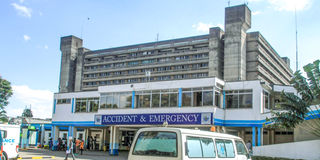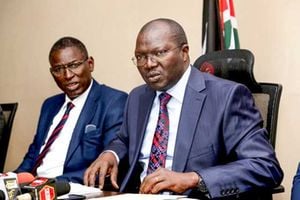Overwhelmed, KNH struggles to care for walk-ins

The Accident and Emergency section of the Kenyatta National Hospital.
What you need to know:
- While it is improper for patients to take themselves to the facility without a referral letter, it is not their fault.
- A gap in the system forces most of them to self-refer.
- In an ideal referral system, a patient has to first attend a level two health facility such as a dispensary run by a clinical officer.
A visit to the Accident and Emergency section of Kenyatta National Hospital (KNH) paints a picture of an overwhelmed facility.
Patients on stretchers, health workers who can barely keep up with the people who swarm into the hospital and staff in general burdened by the work thrown their way.
The hospital is one of the five national referral facilities in the country that ought to receive patients from across the country.
The reality, however, is different, with Nairobi residents having taken over the facility.
In fact, a survey conducted last year shows that 47 per cent of those who go to the hospital come from slums and a majority are often detained for some time due to lack of funds to pay for their treatment.
The congestion at KNH is mostly due to self-referrals. Most people prefer going to KNH without referral from a doctor in the lower level facilities, making it nearly impossible for the staff at KNH to offer adequate services.
While it is improper for patients to take themselves to the facility without a referral letter, it is not their fault. A gap in the system forces most of them to self-refer.
In an ideal referral system, a patient has to first attend a level two health facility such as a dispensary run by a clinical officer.
Ultimate referral points
These hospitals offer outpatient services, including voluntary counselling and testing, pharmacy, laboratory and well-baby clinics.
If the patient does not get the treatment they require they are then referred to a level three facility. Level three hospitals are small facilities run by at least one doctor, clinical officers and nurses offering services such as in-patient care, laboratory, dental, counselling and pharmacy.
They also provide primary care services but with additional support. They include health centres and maternity and nursing homes. Many are currently able to offer in-patient services, mostly for maternity care. These facilities mainly receive referrals from level one and two hospitals.
Level four facilities are the first-level hospitals whose services complement the primary care level. Together with level five facilities, these form the county referral hospitals. A majority of the referrals to this level are from level twos.
Hospitals at this level offer in- and out-patient services and have large laboratories that provide diagnostic services that otherwise would not be available at the primary care facilities. In emergency cases, referrals may also come from lower level hospitals.
Level fives which are the secondary referral level and offer a broad spectrum of specialised curative services.
At this level, facilities are able to offer advanced services and expertise both for curative and diagnostic services.
If all else fails, a patient can be referred to a level six hospital. This category comprises the tertiary-level hospitals whose services are highly specialised. These are the ultimate referral points, mainly national teaching referral hospitals.
The entire cascade and network of referrals in the Kenyan health system is to this level where very specialised skills, expertise and services are offered and linkages with local and international universities, facilities, and staff are forged and maintained.
Nairobi’s referral system is nonexistent; this is due the fact that there are hardly any lower level hospitals within the community.
Build from scratch
Besides, the county does not a level five facility and relies on Mama Lucy Kibaki Hospital, Mbagathi hospital and Mutuini as the level four hospitals.
Most areas of Nairobi have a single government hospital. So, patients walk in to KNH expecting to be treated even without a referral.
As the population of Nairobi County increases the lack of access to hospitals gains traction with most residents saying they do not get quality services.
This is why the Nairobi Metropolitan Services (NMS) has a plan to open 24 hospitals in Kawangware, Kibera, Korogocho, Mathari, Mukuru, Kayole, Viwandani, Majengo, Kiamaiko, Ushirika , Lower Savanna, Zimmerman, Kasarani, Sinai and Uthiru.
Nineteen of the 24 health hospitals are being built from scratch while the rest are being rehabilitated.
Health Cabinet Secretary Mutahi Kagwe says the idea of the slum hospitals was first conceptualised after a visit by President Uhuru Kenyatta to Mukuru kwa Njenga where he noted that there were no level three or four hospitals.
“The President called me during a night visit in the area and asked if I was aware that there was only a small clinic in the area with three beds to serve the community. He then called Gen Badi (NMS director-general) and I to State House the following day and asked us to come up with a plan that will serve residents in the slums,” he adds.
The idea is to ensure Nairobi has a proper referral system which it has lacked since Independence.
Dr Ouma Oluga, who is in charge of Health services at NMS says the county has invested Sh600 million to promote health workers and 44 specialists will be stationed at the Korogocho facility which has stalled for 30 years.
NMS also hopes to complete the Mathare-Korogocho Hospital which will be Nairobi’s first level five facility. The 350-bed hospital will have eight ICU beds and four theatres. NMS will also upgrade Mama Lucy Hospital to a level five facility.
He says these areas were chosen because 4.3 million residents are connected to slums, yet there are no hospitals to serve this population.
The move will see KNH reduce admissions by 47 per cent, with most of the patients being those stuck at the hospital due to lack of funds.
While KNH had hoped to reduce the number of walk-ins earlier, it had been impossible to do so. Their 2018-2023 strategic plan identifies the old and dilapidated infrastructure, staff absenteeism and an inadequate security system as some of the weaknesses hindering delivery of quality services to Kenyans.
It cites staff absenteeism as the cause of low productivity, poor service delivery and increased payroll costs.
For some time, KNH administrators have been pitching for some Sh1.5 billion for doubling the facility’s bed capacity.
Wait for treatment
The administrators say the hospital, which has 1,800 beds, needs the funds to expand this capacity to 3,800. That money is part of the Sh18 billion the officials have been pitching for to finance the hospital’s operations and projects.
The number of patients who stream in has ballooned to an annual average of 700,000 for inpatients and 600,000 outpatients.
In its five-year plan, the national referral facility says by channelling Sh2.9 billion towards the upgrade of the existing services it hopes to relieve the agony of cancer, heart and kidney patients who wait for treatment for months due to lack of specialists and equipment.
But there is a long way before this can happen. Its human resource base – made up of 4,700 clinical and non-clinical staff, is falling short of the 6,200 it requires to operate optimally, says the administrators.
Of its current staff, there are 800 nurses and 227 doctors, meaning the hospital heavily relies on the University of Nairobi personnel, among them the over 700 postgraduate students and their lecturers.
Self-directed referral is also cited as another challenge experienced at KNH because 75 per cent of the people who visit the facility do not come through the referral system.
Hospital records reveal that 250 patients report at the accidents and emergency unit daily from Kiambu, Machakos, Murang’a and Kajiado counties.
The report at the accidents and emergency unit shows that patients from Nairobi are the majority, accounting for 46 per cent of all referrals, followed by Kiambu at 13 per cent and Machakos 6.3 per cent. Others are patients from Kajiado (5.6 per cent) and Murang’a 4.6 per cent.
The target of the NMS programme is to cover 20 per cent of Nairobi’s poor households in the first phase using a tool developed by Health ministry to identify those to be covered.
The county will build 14 level three hospitals and 10 level two facilities at Sh2 billion and will require an extra Sh3 billion to hire 600 nurses, 180 doctors, 180 clinical officers, 50 nutritionists, 100 lab technicians and 44 specialists.
Dr Oluga says the opening of the facilities was based on population, the disease burden in the particular slums and the number of patients stuck at KNH.
“There are no facilities in these slums yet a huge percentage of unimmunised children come from there, the maternal mortality rate is also high in the slums yet women continue to suffer in the hands of unskilled health workers because they have limited options,” he adds.
Malnutrition in the slums is at 4.6 per cent, which is about 50,000 children not having the proper diet, says Dr Oluga.
“Mbagathi, Mama Lucy and Pumwani hospitals cannot cater to the increased population in the county. You also have to keep in mind that Nairobi County public hospitals do not have ICU beds and depend on the national hospitals. So by making Mama Lucy a level five facility, putting up an ICU at Mbagathi and completing the Korogocho hospital by April we will be well equipped,” he says.
Dr Oluga says after the completion of the hospitals NMS will inspect all other facilities and those that do not meet the required standards will be shut.
“After we are done with these projects, Nairobi residents will have access to quality care and so we will do a massive crackdown of all health facilities and also re-inspect the licences the facilities have,” he adds.
According to the CS, the opening of the 24 hospitals will make Universal Health Coverage a reality since residents will have services at their doorstep.
50 years after independence
Once the hospitals are built, KNH can concentrate on the services it is meant to offer, giving opportunities to people from other counties to be treated there.
During the official opening of Kenyatta University Teaching, Referral and Research Hospital last year, the President decried poor health services in slums, more than 50 years after independence and seven years into devolution.
He talked about a visit to Mukuru kwa Reuben where 500,000 people depend on a private health facility with only eight maternity beds. “To resolve this embarrassment, I instructed the NMS to build 24 level two and three hospitals in informal settlements. I note with satisfaction that NMS is on course to deliver the facilities by end of January,” he said.
The NMS has already opened facilities in Uthiru, Dagoretti and Kiamaiko. The President oversaw the grand opening of the Soweto Hospital and a borehole right next to the facility. The health facility offers maternity as well as in-patient services for the residents who often had to go to Mama Lucy Hospital, which is almost seven kilometres away.
“Nairobi residents are suffering. Expectant mothers walk around at night stranded because there are no hospitals. But now, we have promised that we will construct such facilities in every ward in Nairobi and residents will no longer walk for kilometres seeking treatment,” the president said.
The Head of State also launched the Ushirika Hospital in Dandora much to the delight of thousands of the residents and supporters who had followed him on motorbikes from Kayole.
Additional reporting by Stephen Oketch



